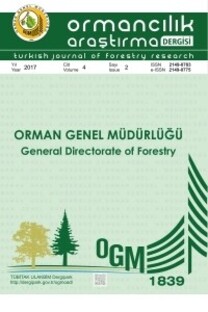Bazı uçucu yağların çam kese böceğine [Thaumetopoea sp.) (Lepidoptera: Notodontidae )] karşı toksik etkilerinin araştırılması
Çam kese tırtılı, uçucu yağ, Sideritis libanotica, Rosmarinus officinalis, Teocrium polium, Thaumetopoea sp.
Investigation of the toxic effects of some essential oils to pine processionary moth [Thaumetopoea sp. (Lepidoptera: Notodontidae)]
Pine processionary moth, essential oil, Sideritis libanotica, Rosmarinus officinalis, Teocrium polium, haumetopoea sp.,
___
- Anonymous, 1995. Harmful insects of forests, The Reports of the 5th Annual Development Plan, Turkey.
- Akkuzu, E., Selmi, E., 2002. The use of microbial control agents against Thaumetopoea pityocampa (Den. & Schiff.). Proceedings of Pine Processionary Moth Symposium, Kahramanmaras¸, Turkey, pp 67–74.
- Avcı M., Ogurlu I., 2002. The importance, biology and natural enemies of the pine processionary moth (Thaumetopoea pityocampa (Schiff.)) in the lakes district. Proceedings of Pine Processionary Moth Symposium, Kahramanmaras¸, Turkey, pp 28–36 .
- Battisti, A., Holm, G., Fagrell, B., Larsson, S., 2011. Urticating hairs in arthropods: their nature and medical significance. Annual review of entomology, 56, 203-220.
- Cetın, H.., Yanıkoglu, A., 2006. A study of the larvicidal activity of Origanum (Labiatae) species from southwest Turkey. J. Vect. Ecol. 31: 118-122.
- Ekerbicer, H., Celik, M., Aral, M., Sasmaz, S., 2002. Harmful effects of the pine processionary moth (Thaumetopoea pityocampa) on human health. Proceedings of Pine Processionary Moth Symposium, Kahramanmaras¸, Turkey, pp 203–205.
- Isman, M.B., 2000. Plant Essential Oils for Pest and Disease Management. Crop Protection ,19: 603-608.
- Kanat, M., Sivrikaya, F.,. Serez, M., A.,2002. Research on the effects of pine processionary moth (Thaumetopoea pityocampa Schiff)), Pinus brutia Ten trees and tending activities on the diameter increment of calabrian pine in Kahramanmaras, Pine Processionary Moth Symposium, Kahramanmaras, Turkey.
- Kanat, M., 2002. The usage of Calosoma sycophanta L (Coleoptera: Carabidae) against pine processionary moth (Thaumetopoea pityocampa Schiff) (Lepidoptera: Thaumetopoeidae) in biological control, Pine Processionary Moth Symposium, Kahramanmaras, Turkey .
- Kanat, M., Alma, M. H., 2004. Insecticidal effects of essential oils from various plants against larvae of pine processionary moth (Thaumetopoea pityocampa Schiff) (Lepidoptera: Thaumetopoeidae). Pest Management Science, 60, 173-177.
- Kesdek, M., Kordali, S., Coban, K., Usanmaz, A. And Ercisli, S., 2014. Larvicidal Effect Of Some Plant Extracts On The Pine Processionary Moth, Thaumetopoea Pityocampa (Denis & Schiffermuller) In Laboratory Conditions. Acta Sci. Pol., Hortorum Cultus 13(5) 2014, 145-162.
- Linskens, H. F., Jackson, J.F, B,1997. Modern Methods of Plant Analysis, Vol. 12: Essential Oils and waxes, Springer, Germany.
- Misra, G., Pavlostathis, S.G., 1997. Biodegradation Kinetics of Monoterpenes in Liquid and SoilSlurry Systems. Applied Microbiology and Biotechnology, 47: 572-577.
- Papachristos, D.P., Karamanoli, K.I., Stamopoulus, D., Spiroudi, U.M., 2004. The Relationship the Chemical composition of Three Essential Oils and their Insecticidal Activity Against Acanthoscelides obtectus. Pest Management Science, 60(5), 514-520.
- Petrakis, Panos, V., 2005. The effect of terpenoid extracts from 15 pine species on the feding behavioural sequence of the late instars of the pine processionary caterpillar Thaumetopoea pityocampa." Behavioural Processes 69.3 303-322 .
- Rabenhorst, J.,1996. Production of Methoxyphenol-Type Natural Aroma Chemicals by Biotransformation of Eugenol with a New Pseudomonas sp. Applied Microbiology and Biotechnology, 46: 470–474. .
- Yiğit, Ş., Saruhan, İ., Akça, İ., 2019a. The effect of some commercial plant oils on the pine processionary moth Thaumetopoea pityocampa (Lepidoptera: Notodontidae). J. For. Sci., 65: 309-312.
- Yiğit, Ş., Akça, İ., Bayhan, E., Bayhan, S., Tekin, F., Saruhan, İ.2019 b.Determining the Toxicity of Some Thyme Essential Oils Against the Pine Processionary [Thaumetopoea pityocampa (Lepidoptera: Notodontidae)] Atatürk Üniv. Ziraat Fak. Derg., 50 (3): 226-230.
- ISSN: 2149-0783
- Yayın Aralığı: Yılda 2 Sayı
- Başlangıç: 2014
- Yayıncı: ahu peruzhan ÖZYAKUP
Ceyhun KILIÇ, Ümit Cafer YILDIZ
Şeyma YİĞİT, İzzet AKÇA, İslam SARUHAN, Selime BAYHAN, Erol BAYHAN, Fethullah TEKİN
Mehmet Tevfik Bey’in 1917 yılı Hendek Orman Fidanlığı raporu ve önemi
Ersin YILMAZ, İSMET DAŞDEMİR, Mehmet ERPULAT, Süleyman ALKAN, Kader Hale GÜLER, Zerrin KOŞDEMİR
Türkiye’nin Karadeniz Bölgesi’ndeki Smilax excelsa’nın meyve ve tohum çeşitliliği
FAHRETTİN ATAR, Ali BAYRAKTAR, Nebahat YILDIRIM, İbrahim TURNA, Deniz GÜNEY
Boylu ardıcın (Juniperus excelsa) yapay gençleştirilmesi
Erdal ÖRTEL, Ali KAVGACI, Mehmet ÇALIKOĞLU, Mehmet TÜRKKAN, Hazin Cemal GÜLTEKİN, Abdurrahman ÇOBANOĞLU
Mehmet Tevfik Bey’in 1917 Yılı Verilerine Göre Hendek Orman Fidanlığı Raporu ve Önemi
ENAT Karacabey endüstriyel ağaçlandırma yatırımında hasılat ve iç karlılık analizi
